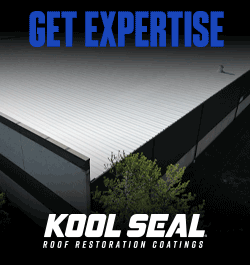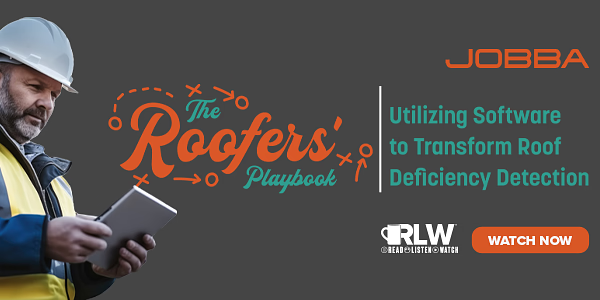The Right Solution for the Right Roof - PODCAST TRANSCRIPT
June 8, 2024 at 12:00 p.m.Editor's note: The following is the transcript of a live interview with Alan Tatum and Jon Feick from Bitec You can read the interview below listen to the podcast or watch the video.
Karen Edwards: Hello everyone and welcome to this episode of Coatings Talk. My name is Karen Edwards and I am your host today, and we have a really exciting topic. We have the team here from Bitec, and we're going to be talking about not just roof restoration, but the important things that go behind making the decisions about finding the right roof for the right building. It's a little more complicated than you might think, and we have Alan Tatum and Jon Feick from Bitec today, and they have been in this industry a long time and have a lot of experience and are bringing us a wealth of knowledge. But before I introduce them, just a few housekeeping items that I want to go over.
This webinar is being recorded, so it will be available online on coatingscoffeeshop.com within about 24 hours of today's session. So feel free to share it with colleagues or anyone else that you think might benefit from this presentation who maybe wasn't able to make it today. And second, the chat is open, so we'd love for you to say hello, tell us where you're from and if you have questions throughout the presentation, go ahead and drop them in the chat. And if we can answer them at the time, we will. And if not, we will save them until the end of the presentation and we'll go through them then. So let's dive in. Alan, could you introduce yourself and tell us about your background and what you do at Bitec now?
Alan Tatum: Yes, my name's Alan Tatum. I'm the technical manager at Bitec, one of the technical managers. We recently hired someone else a couple of months ago, and I've been in the roofing business since 1986. Started out as an apprentice on a commercial roofing crew and eventually became a project manager/estimator for another roofing company and then worked for C-Class for 11 years as field tech and roughly four and a half years as warranty services manager. And then worked for a company called CELUFLEX, which is a coatings manufacturer and a couple other coatings manufacturing companies. Well, Bitec included in that. And this is my second time around at Bitec. I worked for Bitec in Texas in sales for a few years, and I've been with Bitec since January of 2020.
Karen Edwards: I love it. I love it because this industry is very... You can have a nice long career in this industry, and I love the fact that it's your second time around at Bitec because that says a lot about the kind of company that is. And we're going to get into that in just a minute, but I want to be sure that Jon has a chance to introduce himself, and let me get your slide up here, Jon. There you go.
Jon Feick: Thank you, Karen. So yeah, so this career path in the roofing industry is actually a second career for me. I actually spent 20 years in finance. I actually owned my own investment company for 20 years and sold it and didn't really know what I was going to do next. And had a mutual friend that Alan and I know together, and he got me involved in the roofing industry and I served as a sales manager for a couple different roofing companies, getting my feet wet, really learning the industry and then had the opportunity to join Bitec back in 2020 and really enjoyed learning everything from the manufacturing side of the business and had the opportunity from taking that step in to Bitec with one of our sister companies, Viking Products Group, which I'm sure you know very well. And I moved over to Viking as a regional sales and business development manager.
Well, as fate would have it, this is my second stint with Bitec as well, because as of January 1st, Viking merged with Bitec. So I am home again with Bitec and love my colleagues and the family and the home atmosphere we have within this organization. And so now, I am serving as regional sales and technical representative. I cover North Texas, Central and South Texas markets and really am a brand ambassador for our coating systems, I believe. And I spend my days on roofs out talking to contractors and really showing them the benefits of roof coating systems and where they have a place when a contractor is making a presentation to a customer. So really enjoying my second stint at Bitec and looking forward to everything that we have exciting that's in our pipeline coming down in the future.
Karen Edwards: Wow, I love that. I love that both of you were there, we're gone, you're back. As fate would have it, definitely. So let's for those who might not know, Bitec is an amazing company and I had the pleasure of interviewing your president Joel Shealey last week at the Florida Roofing Expo, which by the way, you can go to our YouTube channel if you want to check out the interview. But I've watched Bitec over the last four or five years really evolve into almost a full service provider and solution provider. So why don't you go ahead and just give us the who is Bitec, Alan?
Alan Tatum: Yeah, Bitec was founded by Bruce Shealey in 1986 in Morrilton, Arkansas. And we've been manufacturing SBS and APP membranes at our facility in Morrilton, Arkansas since then. And as you mentioned, in recent years, we've grown, we now have an insulation line, we have fasteners, we have PVC and key membrane system. We have a coal tar pitch that the PVC and the coal tar pitch were part of our merger with Viking or acquisition merger. I'm not sure exactly how you would put that, Jon, but we're back together again. And of course, we've always had roof coatings, but we've expanded our roof coating line over the past few years as well to include some other products. And the past few years have been really amazing because we've grown so much in really just a short amount of time.
Karen Edwards: Oh yeah, for sure. In the last four to five years and managed to do that right when the pandemic hit, right?
Alan Tatum: Exactly.
Karen Edwards: And we had all kinds of challenges and issues.
Alan Tatum: There were a lot of obstacles we had to overcome.
Karen Edwards: Yeah. Yeah, and Bitec persevered and has really achieved the goals that they set out for themselves. So, I'm thrilled. I think you guys are great, and I can't wait to dive in even further onto all the solutions that you have and how it can help when it comes to restoration and making the right decision. Now, everything has to start right before you start any project, everything needs to start with inspections. So Jon, why don't you talk to us? You said you're out on the roof all the time, you're in the field. Let's talk about why this matters.
Jon Feick: Yeah. So when I'm out working with my contractors and we get up on the roof, the things that I'm going to first try to determine is what is the goal of the building owner? What are they trying to get accomplished? That's going to give me an indication of which direction we can look at next. So in those next steps, if they do decide that a coating system might make sense, we want to make sure the roof qualifies as a candidate to be coated. Not all roofs qualify as candidates to be coated. And what I mean by that is we want to make sure that the current system, you may have a leak here and there, you may have many leaks here and there, but we want to make sure that the system itself has integrity. Because if you have a situation you have on your slide here, confirm moisture intrusion, having a leak or having repairs to those leaks on the roof does not necessarily disqualify a roof from becoming a candidate.
But in best practices, what we want to do in an ideal situation is we want to examine the roof further by doing a core sample or moisture scan to find out how much that moisture has penetrated the underlying roof system. Is there an insulation package installed on top of the roof that we would need to be concerned about being wet? So again, we're looking at the roof condition. We're going to make sure that if it's a modified roof system or a single ply roof system, that the terminations have all been done appropriately and they meet code, whatever that local code requirement is and we want to make sure that they are not going to them in and of themselves create a potential leak point. There are some remedies that we can take in the installation of the coating system to remedy those. So again, it's an examination process of the current roof system. It's talking with the contractor and finding out exactly what the expectations are, what the goals are of the building owner to try and then recommend what the next course of action would be.
Karen Edwards: Okay. So you made a real nice segue into our next slide, which is determining the goals, because yeah, okay, we may be having some roof issues, but it's beyond just, oh, let's get up there and restore it because there may be other solutions that are better or more suited. Talk a little bit about what the different goals are that you see out there from property owners or even tenants.
Jon Feick: Yeah, absolutely. So again, I think my year spent in the investment industry, one of the things that they always beat into our head was know your customer. There was actually investment rule. Know your customer rule. Well, I don't think roofing is any different. Know what your customer's trying to accomplish so you as the contractor can present them with the appropriate solutions. So some building owners may be looking at a situation where, "Hey, I am trying to get this roof watertight because I want to sell this within the next 18 months." So they may not be looking for a massive cash outlay and re-roofing the building. They want to make it suitable to where that they can unload the property. So roof coating system may actually be a perfect candidate for that scenario. You have tenants and budget. A lot of the buildings that we work on, maybe a re-roof isn't necessarily a candidate because if you do have... We've done hospitals for coating systems, we've done car dealerships, we've done manufacturing facilities.
A lot of those restaurants, just finished a restaurant in the Dallas area last week, a lot of this can't be shut down for a re-roof. Now, if you have tenants or you have a nature of your business doesn't allow for a re-roof opportunity, a roof coating system may be a perfect candidate. Budget is always a concern. You may have a million dollar taste, but a $200,000 budget. So what solution can we provide from the manufacturing perspective to that contractor that then he can share with the owner to try and come up with the proper solution for that specific property? Property transfer, a lot of times I've done jobs where the roof has been a condition of the sale, so making that roof watertight, whether it be through a re-roof and overlay or a roof coating system that they've already got the property sold potentially pending a warrantable roof situation.
So we can help with that aspect as well. And roof coatings become a very good candidate in that situation. A lot of times we can offer different, and there's other manufacturers as well, but they offer different lengths of warranties. You can do maybe a five-year system, a 10-year system, a 15-year system, a 20-year system even. And a lot of that, again, is going to go back to what that building owner is trying to accomplish. I had a conversation with a contractor yesterday, and it's a converted car dealership that's now a body shop and they're looking for five years out of this because ultimately they're looking to either sell the property or actually demolish the property. So they want a low-cost option that can make that property watertight now. And that's where a roof coating system comes in.
Karen Edwards: So important to really, like you said, know your customer and understand those goals because you may look at a roof and think, "Wow, this is going to be perfect. I can give them a 20-year warranty or a system that's warranted and they don't want that." So I never really put much thought into that part of it before, it was always about let's just get them the best performing roof for the longest amount of time, not even thinking that someone might not want it past five years.
Jon Feick: Sure.
Alan Tatum: Absolutely.
Karen Edwards: All right. So, let's...
Jon Feick: And it may be a situation where you give... And I'm going to transition you into this next one there.
Karen Edwards: Oh yeah, please do.
Jon Feick: So, you may have a situation where the contractor wants to present multiple options to the building owner. Maybe they're not a 100% sure. Maybe the building owner's not a 100% sure what they want. So they may present three different options, like a good, better, best. So they've got a good option would be a roof coating system. It's the least expensive option. You can get the same type of warranty terms and then maybe they give them what they can consider to be a better option, which would be some sort of a roof overlay, maybe using a single ply membrane or modified system. And then they can go all the way up to a full re-roof. So maybe the contractor is showing the building owner three different solutions. Again, a coating and overlaying and a re-roof.
Karen Edwards: All right, so Alan. Yeah, I know you have a lot to add here.
Alan Tatum: Yes. So there are situations where you would not want to coat a roof. Obviously if the roof is saturated or they have multiple leaks and no one can determine the source of where the water is getting in, that's a situation where you would probably want to tear the roof off and figure out where the problems are and then install a new roof. And that would be a long-term solution, certainly. And there are a lot of options when you get into replacing a roof, a lot of different systems and the budget, again, that usually comes down to money, is going to dictate what type of system the owner may want to go with. Certainly they're going to want to pick something that falls within their budget to meet their budgetary concerns.
And those systems could range anywhere from a single-ply roof system to a modified two-ply modified system or a built-up roof or even coal tar pitch, which is a great roof system and potentially lasts for years and years, even possibly someone's lifetime. So there are a lot of options out there, and warranties are certainly a consideration as well. If someone intends to keep that building for a long period of time, they may opt for a premium roof system and a long-term warranty. Whereas if someone is just trying to get a building to condition where they can sell it, they may opt for a less expensive roof system, but for a longer-term warranty to make it more attractive to a buyer. So there's a lot of things to consider as far as the owner of the building, what their plans are and who they intend to sell it to or what potential buyers may expect or won't.
Karen Edwards: Sure. I would imagine that a new longer-term roofing system is going to add some value to the building if they do decide to sell.
Alan Tatum: Absolutely, yes. And that's even Jon and I have actually worked on a project several years ago where the building was in the process of being sold when the contractor brought Bitec in to work with them on installing a new roof. And it was just the perfect scenario. They finished the closing about the time the roof was completed and the new owner received a new warranty on their roof.
Karen Edwards: Nice. I love when that works out that way. Win-win for everybody, right?
Alan Tatum: Exactly. Exactly.
Karen Edwards: Okay, so in the case where the building owner has no intention of selling, what are some of these considerations that they want to take into whether they're going to re-roof, restore? Let's talk about some of these bullet points.
Alan Tatum: Well, in the case of institutions, colleges, hospitals, they typically don't sell buildings. They keep them indefinitely. They typically want a roof that's going to last for many years, potentially 30 or 40 years. They also are concerned about the energy efficiency of the roof, so they're going to want to insulate the roof properly and have something that's going to provide them years of watertight service and also years of energy efficiency. Typically, this would mean installing insulation that has around an R30, something like polyisocyanurate, and then a cover board, in my opinion, if they want something long-term, they would go with at least something like a two-ply modified roof system or a built-up roof or something that has a track record of lasting 25, 30 years minimum.
And then a lot of those cases, the warranties can be extended when you get close to the end of the initial warranty period. So with something like a modified roof or built-up roof, they have a lot of options when they reach that 30 or 40-year mark. And a coating is certainly another option for extending the life of the roof. And that's another area where you could go to an owner and say, "As a manufacturer, we have the warranty on your roof and you're reaching that 20-year mark, we would like to offer you an extended warranty by installing a coating system on the roof." And I think that's where Jon has benefited recently and being able to offer people who are nearing the end of... roofs that are nearing the end of their life, offer them a coating and extend the life of that roof.
Karen Edwards: Yeah, so I'm curious.
Jon Feick: Alan and I actually talked about a very similar situation on Saturday. Customer had a roof situation where it had, I guess, multiple types of roof systems. We had a mansard roof, which was a metal panel, and then the top of the roof was actually a gravel built up. So we were looking at trying to figure out the best solution to share with this contractor because it's going to be very labor-intensive. So Alan suggested looking at a renewable warranty, we do have a silicone restoration system for a gravel BUR, a gravel built up, so we could install that system on top, but then because of the pitch of the metal that was going around on the mansard, you're looking at a lot of labor because of all the coats that would have to be applied thin enough to where you don't have slagging or running of the coating. So that's where Alan suggested, "Hey, let's look at doing a 10-year renewable warranty system on this." And so there's a great catch by Alan there and a great solution that we're able to offer the contractor and the building owner.
Karen Edwards: Yeah, I think that's a great anecdote too, you guys are working on so many different buildings so often and see so many different systems that it's okay to say, "Hey, come on out and take a look at this and maybe someone will have a better idea or a different idea." And I'm just curious from my perspective, we talked about the importance of inspections and starting with inspections at the beginning, but when you're saying, "Hey, we can put a coating system on this existing roof," we're not really even worried about the manufacture of the first system, or as long as we've done our inspection and our homework and done those moisture scans and made sure the roof is in decent shape, that doesn't really affect the warranty you can offer, right?
Jon Feick: It can. We definitely in best practices when we inspect the roof, we do a visual inspection typically with the contractor and then there are things that we want to do to ensure the success of the roof coating system. Moisture scan is one, core sample is one. We want to see what's going on underneath the surface, but then to ensure the long-term adhesion of the membrane, of the fluid applied membrane, we want to do an adhesion test so we can assist the contractor with testing that roof in several areas to make sure we have proper adhesion of whichever coatings technology we're going to look at using on that roof. And sometimes we may do multiple tests with different technologies. We may use a rubberized coating in one test area, we may use a silicone in another, we may use a primer with a silicone in a particular area.
So we're going to find out which one of those systems and offer them different options within the coating realm to see which one is going to have the best long-term success. So we do want to pay attention to what the existing system is. One thing I do want to add to that point is the old school of thought was that silicone could not be coated. That's changed as technologies and have improved within silicone. I know at least with ours, through personal experience, I've had no adhesion issues through the tests that we've done over other manufacturers existing silicones. So, I know the old school of thought was you can't do it or if you're going to do it, you have to use the same manufacturer that was down the first time. I think a lot of that has changed, but again, best practices, you'll always want to perform an adhesion test to make sure there's not going to be any issues there.
Karen Edwards: Right. Yeah.
Alan Tatum: Yeah, something else that I wanted to bring up is if there is an existing warranty on a roof system, we don't want to void the building owner's warranty by installing a coating over that roof system. So, it's important to make sure that all parties involved are okay with installing a coating on a roof and the owner should be aware that they may be voiding any type of manufacturer's warranty that they have when they do coat a roof. So something to take into consideration.
Karen Edwards: No, that's a very good point, Alan, because maybe you've got two years left on that roof, and so maybe now's not the time, right?
Alan Tatum: Exactly.
Karen Edwards: Maybe you wait two years and then you can plan for it and budget for it and know that you still have that peace of mind from the original warranty, and then you're going to get another one when the restoration system is installed. Okay. So, I think you had mentioned this Jon earlier about rapid property transfer. What kind of situations is this just somebody just is like the building's for sale, I got to go, I'm closing on this other building next week and I need it done? What kind of situations do we see that the restoration or a coating system could help in this situation?
Jon Feick: Yeah, kind of a hodgepodge there of what you see and what's out there. You may have a building that is for sale, they know they need to have a roof done. Maybe it's a situation where again, it's a condition of the sale and the buyer is going to have input on what type of roof system goes into that. That can be all negotiated in the selling process. The buyer may again want to be going with the least expensive option being that they're already having a huge outlay, whether it be cash or financing or whatever on that roof system to attain that building. So they may be looking for the least expensive option to give them a warranty. So you see situations like that where it's a condition of the sale and the building that the new owner has input on what type of system goes on. It could be you're planning for a sale, and hey, I'm going to put this on the market in a year, but I know I'm going to have to get a roof, so let's look at what my options are and plan for that.
It comes back to inspection. What is the current situation of the roof? I mean, we want to see if it qualifies for a coating system or if a re-roof is going to be the only option. One thing that Alan and I haven't touched on yet is how many layers is already on the roof? How many roofs does it already have? If you've got two roof systems already on that structure, you can't do an overlay in most situations that I'm aware of. So municipal ordinances won't allow it, so code wouldn't allow for a third roof system to go on there. In most instances, and I have come across where municipalities have said a coating system does count as a roof system, but in most instances, a coating does become your only option other than a re-roof. So that's something else that can be considered as well.
If you've already got two roofs on there and you find that out, again, by doing your core sample to see what's underneath the surface, see what you can't see. So we want to do an inspection report with the customer and take all that into account. Insurability is a big one quite honestly, and I think it's going to become more and more prominent. I think you're going to see this more and more. Through folks I've talked to over the last several years, especially in the Dallas area, we got a lot of hail and there's a lot of hail claims in this area. Sometimes that money that is paid out on a hail claim for a roof is not necessarily spent on the roof. I know we'd all like to think it's a perfect world, and that happens, but sometimes building owners choose to spend that money elsewhere.
What ends up happening is that claim stays in the insurance system. So when that property comes up for renewal, the company that paid out the claim may want to verify that work's been done. Or if they're trying to shop the insurance around, the new company may see, "Hey, you had a roof claim last year. I want to come out and verify that work's been done on the roof." So a lot of times you'll run into a building owner that says, "Man, I got the insurance check. I spent the money. I've got to get something on this property because my insurance is out in two months." So that does come up, and I think it's going to become more and more prevalent as insurance companies get tighter and tighter in paying claims and wanting to make sure that the claims they have paid, the work's actually done.
Karen Edwards: Yeah, we see this a lot in residential. I know in the state of Florida, there's homeowners that are receiving letters from their insurance company saying, "You need to do something about your roof or we're going to cancel your policy." Is this happening in the commercial space as well?
Jon Feick: It is. I'm hearing stories about it. I had a contractor tell me that the building owner got a million dollar settlement from the insurance company or got a million dollar insurance check and basically said, "I'm better off taking this million dollars and investing in a new real estate than putting it into this new roof. When it's time to come do the new roof, I'll address it at that time, but for now, I've got a million dollars sitting here. I'm going to go out and invest it in other real estate." So obviously not the way it was intended, not the way it was designed, but it happens and we certainly don't condone that.
Karen Edwards: Right. Right. I know. Alan, did you have anything to add there?
Alan Tatum: Well, this isn't exactly along the same lines, but a coating is considered maintenance. So from a tax standpoint, if a property owner installs a coating, in a lot of cases, they can take 100% of that depreciation in that calendar year. So that might be another reason that they decide to go with the coating option as opposed to replacing their roof, because if they plan to sell the building, they don't want to wait five years to get that full depreciation or 10 years or maybe even longer.
Karen Edwards: So that's an interesting point because of is it maintenance or is it a roofing system and what determines whether it's maintenance or a system? Because we're hearing more of the coatings being coatings systems.
Alan Tatum: Yeah, I think that's a fine line because a coating in some cases could just be used to make the roof reflective to meet local code requirements. In other cases, a coating could be installed to help protect a roof that's nearing the end of its life and give it a longer life and some waterproofing benefits. But not every roof that gets a coating is necessarily getting it to extend the life. It could just be-
Karen Edwards: Energy efficiency.
Alan Tatum: ... for energy efficiency.
Karen Edwards: Okay.
Jon Feick: And Karen, I know [inaudible 00:32:43]. So, the NRCA actually, I read a release that they had made in regards to the IBC 2021. There is language in the 2021 IBC that the NRCA has talked about that tries to clarify what the differences are in still indicating that a roof coating system is not necessarily a roofing system. So again, I ran into this with a local municipality here in the Dallas-Fort Worth area that did consider a roof coating, Alan, you were on that roof with me, that was that church we looked at.
Alan Tatum: Yeah.
Jon Feick: But they did consider a roof coating a roof coating system that already had two layers or two roofs on it. So the city would not allow a roof coating to go on that. But every situation is different. There's not a cookie cutter one size fits all. I would, again, talk to your local municipalities, find out what the code is in that area. Different municipalities have adopted different versions of the IBC. So again, I would talk to your local municipalities, find out what your local codes are and go from there. But I did want to touch on, you talked about trying to get a job done by the end of the year for tax purposes, because again, typically coatings are maintenance and not depreciable. They don't have to be depreciated over the life of the roof system. So I got a call a couple of years ago on Christmas Eve from a contractor said, "Can you help me? I've got to get this job done by December 31st because the building owner wants to write off."
Karen Edwards: Oh, no.
Jon Feick: So, we were able to fortunately help that contractor out and get that job done. I think he finished it on December 31st. The weather here in Dallas cooperated. So we were able to get that system done, but that contractor was able to be a hero to his building owner.
Karen Edwards: That's a nice little nugget. We always say, when going to attending webinars or educational sessions, if you can find a nugget to take away, and that could be a really good sales tool toward the end of the year by saying, if this coating is going to qualify as a maintenance, and you can deduct that, talk to your accountant, of course, we don't want to give tax advice, but typically you're able to do that. That could help you close that sale and get a job in before the end of the year. And I do want to say thanks to Kyle for his comments in the chat about fabric or foam typically make it a system and coating alone is maintenance and that's what we all say.
Yes, except your example of in Dallas, unfortunately that wasn't the case. So all righty. And I'm just following along if you have a good accountant. Yeah. Yes, so true. Thank you Kyle for that. Okay, so well, we've talked a little bit about this, but there's a lot that goes into, we know you can repair, you can restore or you can replace, but a lot of this comes down to the conversations that you're having with that building owner and with your customer and understanding their needs. So Jon, why don't you get us started on this and talk through it?
Jon Feick: Yeah, of course. So again, it comes down to working with your contractor, finding out what the goals of the building owner are and trying to then from that conversation to determine what solutions that you can provide that contractor. So what ammunition you can provide that contractor. Then to then go back to the building owner with solutions, on the restoration side, typically that's going to be your least expensive, least invasive option. Most of the time you can qualify for 5, 10, 15, 20 year NDL warranties. So that doesn't really change whether you go then to an overlay or a full tear off and a re-roof. Most new systems are going to offer you the same options, a 10, 15, 20 year NDL. A lot of it comes down to, again, what the building owner's trying to accomplish, what the roof looks like and then what kind of business do they run?
Is there going to be much disruption? With a re-roof, obviously you're going to have the greatest amount of disruption to the business typically, unless they're working at night or something like that. So this restaurant that we just finished in Dallas last week couldn't shut down. They were open from 11:00 AM to 11:00 PM every day, and they had no intentions of closing the doors. And this particular restaurant had cooks that were going on overnight. So we had to be cognizant of that during the coating install, but a re-roof was not going to be an option because of the disruption to the business. I worked with a contractor on a hospital over in Fort Worth and same thing, they couldn't close the doors. It's a hospital. So what are our options? We put a coating system down, and on that, we used a silicone coating system.
Our silicone is a low VOC. It does have some fumes, but not as intense as some other technologies might, adhesives with an overlay system. If you had a single ply adhesive that has high VOCs, high fumes, you don't want to infiltrate that in the building, especially in a hospital setting. If you have a residential property, it would be the same thing. So you want to be cognizant of those issues as well. So I think it comes down to making the determination between repair, restore, replace, how prevalent is the damage to the roof? Do you have ponding water? We have solutions that can fix that. Do you have wet insulation? Is that going to be an issue? How much of the insulation is wet? Again, looking at trying to determine what the building owner wants and providing the best solutions. And a lot of that does boil down to education, educating the contractor so then the contractor can educate the building owner to come up with the best plan of action for their particular situation. And every situation is different.
Alan Tatum: Yeah, I can't say this enough, not every roof is a candidate for a restoration or a coating. There are roofs out there that are beyond saving, and I get pictures of them every day from sales guys that want to put a coating on it.
Jon Feick: Not me.
Alan Tatum: But we can't do that, this roof is shot, it needs to be replaced. And unfortunately, I think there are times when roofs are coated that should have been replaced and that you're really doing a disservice to the owner when you do that, because that coating, instead of buying them five or 10 years, may only buy them a couple of months before they have to actually look at doing something else.
Karen Edwards: Yeah, and that gives coatings a bad name then, right?
Alan Tatum: It does.
Karen Edwards: Because that experience that they have, they're like, "I tried that, that didn't work for me."
Alan Tatum: Well, I've always said it's not a miracle in a bucket. There's no such thing as a miracle in a bucket. And if a roof is leaking, you should determine the source of those leaks before you even install a coating on it, because a coating may not fix those leaks, and in most cases, it won't. It might be a temporary fix, but it's not a long-term solution. The only place it is a long-term solution is on metal roofs. In a lot of those cases, it does prove to be a long-term solution, but on membrane roofs, you really need to determine where your problems are and resolve those issues before you try to coat. Or maybe you determine that the coating isn't going to fix that roof. It's saturated and it needs to be torn off and replaced.
Karen Edwards: Which the perfect segue, oh my gosh, it's almost like you guys practiced. We've talked about this, the options for the re-roof, you mentioned this a little bit earlier in the webinar, but is it an option to get rid of what's there and come back with some type of coating system or what kind of options are there for that?
Alan Tatum: Actually, there are some hybrid systems out there that where you install maybe a modified sheet and then install a coating on top of that, or two modified sheets and a coating. We've even done projects where we installed a modified bitumen roof and then came back and installed the coating several months later just so it could meet the code requirements for the municipality. Coal tar pitch is a separate animal. There aren't a whole lot of people lined up that want to put it and want to install coal tar pitch or even know how to, really, it's a dying art because it does require some skilled labor to install. Same thing with built-up roofs. It does require specialty equipment and a skilled labor that knows what they're doing. Single ply does still require some skilled labor, but it doesn't require the amount of equipment that's required for a built-up roof, for coal tar pitch roof and modified. And then coatings, probably I won't say that it doesn't require skilled labor, but it is probably lower down on the skill level as far as what's needed to apply coatings.
Karen Edwards: Right.
Alan Tatum: I wouldn't say that in front of mine and Jon's friend, Tim, but he's certainly ill at what he does. But so the options are many and it always comes down to money.
Karen Edwards: Yeah, and I think the goals as well, right?
Alan Tatum: Exactly.
Karen Edwards: If it doesn't need a re-roof and the use of the building, we talk about if it's food processing, if it's manufacturing and we could talk another hour about that. So we're not going to, because we're getting close to 45 minutes in here and I want to make sure we have time to cover the rest of our topics.
Alan Tatum: Absolutely.
Karen Edwards: So, we move on to the restoration and types and the considerations. So we've made that decision, yes, this is a good candidate. Now, how do we pick? Let's talk about that.
Jon Feick: Sure. I'm going to, for time's sake, skip right ahead into the fourth of your bullet points there, silicone, because we're assuming at this point, we've already determined that moisture is on issue, but we don't have saturated insulation warranty. We've already discussed a coating system. We can offer the same length. Typically, the NDL as either a single ply, full re-roof or a modified system would, the condition of the roof, let's assume we've already said, "Hey, this is a good roofing candidate. The condition qualifies this roof as a candidate." So then it's determining which technology you're going to use. Silicone is, when I'm talking to contractors, typically my preference on any low slope roof system, if you're looking at an existing modified roof or if you're looking at an existing single ply or even EPDM, silicone is my first go-to. I know with our particular line, we have a high build silicone that oftentimes can be applied in a one-coat application.
So it does end up saving you time and money on the labor side as well. Plus silicone is extremely resilient to standing water. Best practices, you don't want to have any water that stands on the roof for more than 48 hours that you want to alleviate that, if you know that's a known issue on the roof, you want to alleviate that in the installation process. But again, on low slope, I'm going to go with silicone. I'm going to recommend silicone to my contractor nine times out of 10. The application of silicone on low slope is one thing that does need to be considered. It's real easy to back roll silicone on low slope roof systems. So pretty much anybody can do it as long as they know what they're doing. It doesn't take a lot of special equipment, is what I'm saying. You can spray silicone, but that would take a special spray rig that can pump out enough pressure to make sure that the silicone atomizes correctly and is applied at the appropriate thicknesses.
But again, on a low slope, that doesn't always have to be a concern because it's very easy to back roll. Acrylics, so when folks talk about elastomerics, pretty much all coating systems now are elastomeric, but when somebody uses that terminology, they're talking about the old days. Acrylic was pretty much the first reflective roof coating system that came into prominence. So you do see a lot of acrylics out there and still a lot of contractors that prefer to install acrylics on low slope and on pitched metal. For me personally, when I'm talking to contractors and I'm looking at jobs, acrylics are going to be very applicable in pitched metal situations. You can spray it very easily. The spray rigs to spray acrylics are relatively inexpensive and acrylic cleans up very easily. So because it's a water-based product, if you do have overspray and you get it on cars or something, very easy to clean that acrylic up versus the silicone.
So you want to take those things into consideration as well. Acrylic, and I know there's proponents on both sides. I've seen a lot of acrylic installations on low slope roof systems that have failed. And a lot of that is again, in the prep, because if you do have standing water and it stands on an acrylic roof system, the water acts as a solvent to a water-based product. So you get flaking and peeling and cracking, and a lot of that happens at a very short-term process. Typically, your acrylics are going to be a two-coat at a minimum, a two-coat roof system. The roof that Alan and I were visiting on over the weekend, the mansard section was a 12-pitch metal and to spray that on at the appropriate thicknesses to achieve the desired length of warranty was going to be multiple coats. So you don't put it down too thick and get running of the product.
So acrylic for me is going to be reserved for pitch metal. So anything that's the four-pitch and above, I'm looking towards acrylic. As long as you have positive slope on a metal roof, acrylic's fine. So one, two, three-pitch is fine as well. Again, it's going to be a two-coat roof system versus a one-coat roof system with the silicone. SEBS, it's a new technology, well, I don't know if it's new, but it's a technology that's come on and particularly here in the Texas market, I think is very attractive for metal roofs. The SEBS is a rubberized coating. The rubberized coating, the way that it is manufactured has thermal elastic properties to it, and it typically has a higher elongation. Typically, it's got about twice the elongation of silicone and about five times the tensile strength. So for metal roofs in the Texas environment where you've got expansion and contraction of that metal roof system, you can literally stand under a metal roof and hear it buckling as the sun's going up and it's getting hotter during the day.
A rubberized coating, SEBS technology is a preferable on metal. I think it's a premium product for a metal roof system, but it really, I think, lends itself to metal the best. It can be used on other roof systems as well. The one thing you want to be sure of if you're using it on a low-slope environment is again, you don't have any moisture because it has very little permeability. So, if there's any moisture either on that roof's surface as you're installing it or in the insulation package, that could seep out, you're going to get bubbling up of the coating system because has very little permeability. But for me, again, SEBS which is a rubberized technology, I reserve that for metal roof systems.
Karen Edwards: Excellent. Wow, what a great overview. Thank you. So let's move on and talk about the importance of experience technicians. We've said that it's not extremely difficult to install, you don't need a lot of specialized equipment, but it's still important to have that knowledge of what you're doing. So let's talk about that. Maybe Jon, you want to get us started here?
Jon Feick: Yeah, I mean, I think it goes again, understand what you're inspecting. So seeing the roof system, finding out what the goals of the building owner are, what the contractor wants to present to the building owner are, what qualifies that roof system for the various systems we've discussed, what's the scope of work look like? I mean, how much... Alan talked about repairing any leaks. I mean, obviously if you have a lot of leaks on that roof, that is going to be a factor in determining whether or not it's a coating candidate or not. And if it is, how much added labor are you looking at in repairing that roof to make it a situation where it's coatable, what I tell contractors is 90% of the success of your roof coating system is in the preparation of their job.
So if you do your prep work properly, if it's a metal roof and you're doing seams and screws, or if it's a modified roof and you got to roll your seams or repair any loose seams or anything like that, make sure all your penetrations are watertight, a lot of that's going to be in your preparation. So documentation, when I am doing a job with a customer, we're going to do a pre-inspection, take photos, all that is submitted along with any documentation we have on the building, what type of structure it is, number of squares, et cetera. All that is submitted to our warranty department before the job begins. That way, if I've missed something, Alan can catch it and say, "Jon, did you see this? What are we going to do to address that situation?" So we work together on that. We communicate with our contractors, with our building owners. If there's something that our warranty department or our technical department sees that maybe I've missed, we can discuss it before it becomes a problem on the job.
And then when we're done, again, we take photos, we do an inspection. If there's anything that doesn't match our design specifications or something that needs to be addressed, we do a punch list, tell the contractor, "Hey, this is what we need to have fixed." Sometimes that comes from me doing the inspection. Sometimes it comes from our technical department, say, "We want to see that this has been addressed better," or something like that. So again, we turn in our photographs and then once all that is done, the punch list is done. We issue the warranty. But I think it all comes down to communication within the team, within our Bitec family, and then the relationship you have with the contractor to be open and honest with the contractor, and then make sure that that contractor has the relationship with the building owner to be open and honest with them about what their options are for a particular roof system.
Karen Edwards: Yeah. Yeah, well said. Thank you. And then it comes down to training. Like we said, it's not very difficult. It doesn't need too much specialized equipment, but understanding the basics behind it, you guys have a lot of training options. So can you talk a little bit about that? Maybe Alan, you want to get us started here?
Alan Tatum: Yeah, we do offer on the job site training. I was doing some of that earlier this week actually. I don't mind going out into the field and working with the contractors people to get them up to speed. We can also refer them to some videos of application techniques, and we do trainings at distributors where the contractors can come to the distributor. And Jon and I have done some of these this year where they bring people in and we demonstrate the application techniques of the products. They explain how they're used and offer advice and our expertise in how to pursue projects and how to install a project successfully.
Karen Edwards: I think we're going to see, because a lot of building owners, property owners, I do it, everybody does it. You've got something coming up, you're searching on the internet, what are my options? You're saying, "Hey, look at this, there's a roof restoration," and it's been growing and growing. It's a really hot topic.
Alan Tatum: One of the fastest growing segments of the commercial roofing industries for years now.
Karen Edwards: Right. Right. And so there's contractors out there that maybe say, "Well, I've never done it before, but I need to add this to my repertoire or my offerings." So this is where a team like Bitec comes in and can show you the ropes, can be on that first job with you, the first day that you're starting to get that roof in shape to receive that coating.
Alan Tatum: Absolutely.
Karen Edwards: And kind of hold your hand through the first job. I would be nervous if I go to classroom training or I did some online training, but I'm going to actually be in the field doing it. And that's one of the big things that you offer to your contractors.
Alan Tatum: Yeah, and one of the things Jon has done is he's tried to work with a core group of people that are qualified, and they've actually helped to train other people. So having a core group of installers that you can count on to do the job right is key. But then if you can help them train other people or work with other crews, then they share their knowledge. That certainly helps. And Jon has done a great job of getting out in the field and learning about how the products are installed, and then being able to explain that to the other new contractors that come on board. So we're all about helping our contractors. They're our partners, they're our friends. We want to make sure they're successful, because if the contractor isn't successful, then manufacturer isn't going to be successful.
Karen Edwards: Right, and the owner's not going to be happy either, right?
Alan Tatum: Exactly. And that's the key. The owner is ultimately the customer for everybody.
Karen Edwards: Absolutely. Absolutely. Alan, Jon, you guys, this was a fantastic conversation. If anybody has a question, get it in there now because we're wrapping it up here at the top of the hour, I think we've addressed the comments that we did get, but I just want to say thank you. Thank you all. Thank you to Alan and Jon from Bitec. Thank you for putting on this presentation. And like I said, it will be on demand within 24 hours on coatingscoffeeshop.com. And be sure to visit the website and you can check out Bitec's directory. So if you're watching this on demand and you didn't get a chance to submit a question and you find you have one, their contact information will be on their directory listing on coatingscoffeeshop.com. They're also on rooferscoffeeshop.com. So thank you all for being here.
Alan Tatum: Thank you.
Karen Edwards: We do one of these webinars every month, so we hope to see you on a future one and we hope that we've been able to help you find success in your businesses. So thanks, Jon. Thanks, Alan.
Alan Tatum: Thank you.
Jon Feick: Thank you.
Karen Edwards: All right. See you next time everyone. Bye-bye.
Alan Tatum: Bye.























Comments
Leave a Reply
Have an account? Login to leave a comment!
Sign In